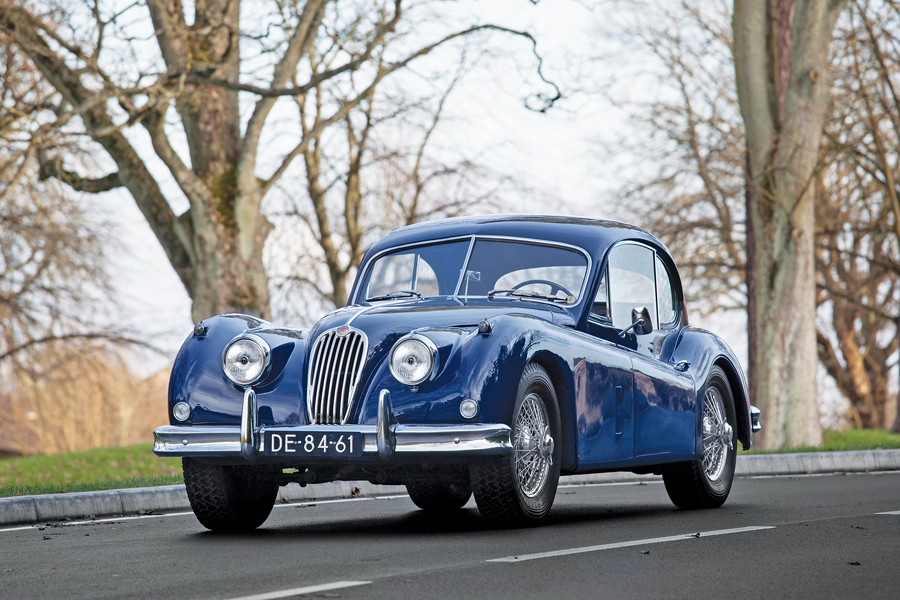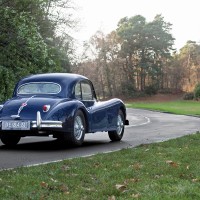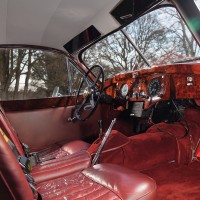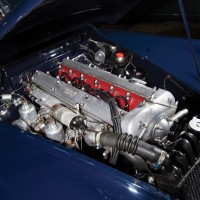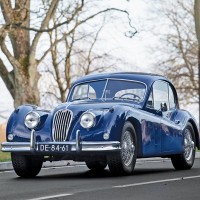SCM Analysis
Detailing
| Vehicle: | 1955 Jaguar XK 140 SE coupe |
| Years Produced: | 1954–57 |
| Number Produced: | 8,937 (1,959 LHD coupes) |
| Original List Price: | $4,000 |
| SCM Valuation: | Median to date, $84,100; high sale, $181,500 |
| Tune Up Cost: | $400 |
| Distributor Caps: | $18 (£11.95 on eBay) |
| Chassis Number Location: | On plate riveted to firewall or inner wing |
| Engine Number Location: | Right side of block, (carbs side), on oil filter mount, and rear face of cylinder head |
| Club Info: | The XK Register |
| Website: | http://www.jaguardriver.co.uk |
| Alternatives: | 1953–57 Aston Martin DB2/4, 1954–63 AC Aceca, 1955–57 Chevrolet Corvette V8 |
| Investment Grade: | B |
This car, Lot 130, sold for $61,944, including buyer’s premium, at RM Sotheby’s sale in Paris, FRA, on February 3, 2016.
Full disclosure: I have not seen this car in person. But luckily SCMer and XK 140 owner Joseph Seminetta did, as he was covering the RM Sotheby’s sale, and I am indebted to him for his description of the car — and his notes and guidance.
First off, this car looked unusually cheap, as sharp XK 140 coupes retail in the U.K. in the £75k–£90k ($114k–$136k) range, depending on how ambitious the dealer is.
By pure coincidence, the day before Executive Editor Chester Allen asked me to profile this XK, I had driven one almost identical at U.K. dealer Pendine, which was asking a similar price to this — £52,500 ($74,362).
On that car, the paint was rough, but in its favor it was a very original, home-market, right-hand-drive car that had never been significantly apart. So the door fit — often a weak point on these, especially restored cars — was as-factory, and it drove as you’d imagine it did when it left Browns Lane 61 years ago. Maybe better, as it sported discs from a Mk IX Jag, plus two-inch SU carburetors.
Deciphering XK 140 coding
Our subject car was in the same price range, and it was an SE model (designated MC for U.S.-supplied cars), which confers an extra 20 bhp over the standard 190, but it didn’t appear to be as original, with a slightly indifferent repaint, a re-trim at some point, and engine/cylinder head number G56178S, which might or might not be the original.
The head was painted red, some of it having flaked to silver, with traces of green at the edges.
Standard cars had the A-type head unpainted, while SEs had the option of the C-type head painted red. Green means a B-type head. Confusingly, all XK 140s had G engine number prefixes.
Both standard and SE could have 7 or 8:1 compression ratios, and in this case it’s 8:1, as denoted by the 8 suffix. This car also has an S suffix stamped in the cylinder head, further adding weight to the claim that it’s a C-type head.
A real C-type head has C cast in the vee between the camshaft housings, but we couldn’t see that, although it did wear “Type C”-badged cam covers.
The S prefix on the chassis number denotes SE spec. So let’s assume that the head, at least, is the correct spec, but without access to the JDHT certificate, there’s no way of telling if the motor is the original. Generally, unless an auction catalog specifically makes the claim that the subject car is numbers-matching — with the same major componentry it had as it left the factory — I assume it’s not. As an SE, it should have spotlights mounted above the front bumper just inboard of the indicators, but that’s a minor detail, and the car looks cleaner without them.
Some warts, but a lot of good, too
With harnesses and a tripmeter, it had obviously been used for rallies, and it rode on quite fat radials. For all that, the body looks straight and the door fit was pretty good. As usual, some of the chrome was pitted — the door and trunk handles always get a bit pickled on these — and if the taillight castings are smooth, they’re probably repros. Some of the body moldings were wavy.
Joe Seminetta noted that the trunk lid was reluctant to latch, although RM Sotheby’s staffers managed in the end. There were no tools included, but it did have a Jaguar Daimler Heritage Trust Certificate confirming it was what it said it was, although I wish I could have seen it to check whether it still had the original motor.
“I rated the condition as 3-minus,” Seminetta said. “It had thick, wavy, non-original paint (color change from Birch Gray). Pieces of its molding were falling off.
“The chrome was deeply pitted. Panel fit was about correct. The interior was a bit nicer (if you can look past the Schroth racing straps and fire extinguisher),” he said. “The wood was nicely finished (not claimed to be original). The seats had a nice patina but are also not claimed to be original.”
So, why so cheap?
All that sounds normal, and I don’t think there was anything fundamentally wrong with this car. Add points for SE spec, take some away for non-original color — maybe take away a few more for a replacement engine — and the fact that it’s obviously been used for rallies.
But the reason for the lowish price might be more basic than spec and condition — down to the caliber and location of the sale.
In a room full of much-more-expensive cars (and more to choose from the same Rétromobile week at Bonhams and Artcurial, which sold the Ferrari 335 S for $35.7m), perhaps our XK 140 SE just got slightly overlooked in more exalted company.
If that was the case, and there was nothing seriously wrong here, the successful bidder bought well. The catalog description touted it as “the perfect historic rally entrant,” and I’d say that’s spot-on. ♦
(Introductory description courtesy of RM Sotheby’s)
